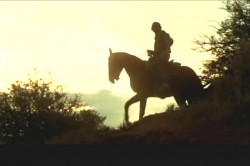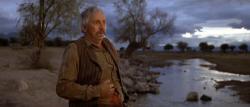Reviews
Monte Hellman
USA, 1966
Credits
Review by Cullen Gallagher
Posted on 03 April 2013
Source Vci Video DVD
Categories Acid Westerns
“Hell, I don’t see nothing. What are we following, anyhow?” Coley Boyard asks his mining partner Willet Gashade midway through their journey. More than just articulating the uncertain trajectory of their travels, Boyard’s question haunts the entirety of The Shooting, ultimately expressing the film’s trance-like tenor, narrative ambiguity, and moral ambivalence.
From its opening shot of a perturbed horse looking suspiciously around the stream, accompanied on the soundtrack by a shrill atonal flute melody, The Shooting abounds with a disquieting aura of unease. It is less of a story than it is a mirage. The Last Year at Marienbad of Westerns, The Shooting unfolds as a series of successive but incomplete puzzles. It fascinates through its obscurity. One mystery leads to another mystery that leads to another mystery that leads to yet another, none of which are ever fully resolved, but which by the film’s end have given way to yet another hazy image, another illusory reality.
After years of television appearances and supporting roles in feature films (including Sam Peckinpah’s Ride the High Country and Major Dundee), Warren Oates plays his first leading role as Willet Gashade, a former bounty hunter turned prospector. Directed by Monte Hellman and written by Adrien Joyce (penname for Five Easy Pieces scribe Carole Eastman), The Shooting is structured like a perpetual cinematic matryoshka doll that has no clear beginning or ending.
The film begins when Willet returns to the mining camp and finds his partner Coley Boyard scared into hiding. While Willet was gone - where, why, and for how long it is never explained - much has happened at the camp. Coley tells of Gashade’s bother, Coin, who ran over someone in town with his horse—it may or may not have been a child. The next morning, Coin fled on horseback. Shortly thereafter, an unseen assassin shot their other partner, Leland. Willet adds his own mystery to this already web-like tapestry: “I’ve been trailed most of the way here, by I don’t know who.”
Before Willet and Coley can make sense of what has happened, a woman approaches them, asking to purchase a horse and hire them as a guide to Kingsley. A female analogue to Eastwood’s “Man With no Name,” this woman does not identify herself, where she came from, or what she is after. Along the way, she is joined by a gunfighter, Billy Spear. As the journey to Kingsley progresses, Willet follows a trail left by his brother, Coin, and begins to suspect that the woman and Spear may also be tracking him.
The further the group travels, the closer they should be getting to Kinglsey. Excepting a single frontier town stopover early in their journey, however, they seem to be moving further and further away from civilization and deeper into the barren, sun-scarred wilderness. In Hellman’s compositions, the characters are overwhelmed by their geographical circumstances. People are frequently framed in long shots in which the landscape stretches out seemingly forever, only to evaporate into the oblivion of a blinding horizon. There is no direction to these shots, no markers of civilization, no way to gauge movement or progress. Even the editing style of The Shooting obscures any sense of orientation or advancement. Furthermore, Hellman’s desert visions are strangely claustrophobic. In contrast to the wide-open spaces, the stark visibility precludes any chance of hiding and makes escape impossible. Unlike the traditional western vista that represented hope, inspiration and liberation, this limitless horizon offers boundless entrapment and desolate isolation.
This sense of abstract pursuit picks up a similar thread from Hellman’s previous film, Ride in the Whirlwind, shot back-to-back with The Shooting, and featuring some shared cast members (Millie Perkins, who plays the unnamed woman, and Jack Nicholson, who plays Billy Spear, both appeared in Whirlwind). The plot of Ride in the Whirlwind concerns three drifters who are mistaken for outlaws and chased by a posse. Ironically, the chase gives definition, intention, and direction to the drifters and their directionless lives. The Shooting similarly uses a narrative framed by vague pursuit to pose larger philosophical questions:
Woman
You won’t get there that way at all.Willet
Then why would someone want to go this way?Woman
To get themselves lost is the only reason outside of ignorance that I can give.Willet
We’ll follow it, Mr. Gashade.
The finale reworks one of the most iconic tropes of the Western genre: the shootout. This showdown, however, is not situated in the neat confines of Main Street, nor does it have the simple binary of “good vs. evil” or even the comforting ritual of a high noon draw. Instead, atop a mountain, The Shooting continues its enigmatic trajectory into the existential. Playing with the frame rate, slowing down the action and eventually halting the images to a standstill, Hellman only exacerbates the surreality of the narrative, evading any sense of finality or closure.
Watching The Shooting is an abstract experience, and the film’s ambiguities will either excite the imagination through contemplation or frustrate through confusion. If one can align their mindset with the film’s hazy ambiance, The Shooting can offer one of the most unique, if slightly hallucinatory, journeys in the Western film canon.
More Acid Westerns
-

Ride in the Whirlwind
1965 -

The Shooting
1966 -

El Topo
1970 -

The Hired Hand
1971 -

The Last Movie
1971 -

Greaser’s Palace
1972 -

Bad Company
1972 -

Ulzana’s Raid
1972 -

Jeremiah Johnson
1972 -

Pat Garrett & Billy the Kid
1973 -

Kid Blue
1973 -

Dead Man
1995
We don’t do comments anymore, but you may contact us here or find us on Twitter or Facebook.



